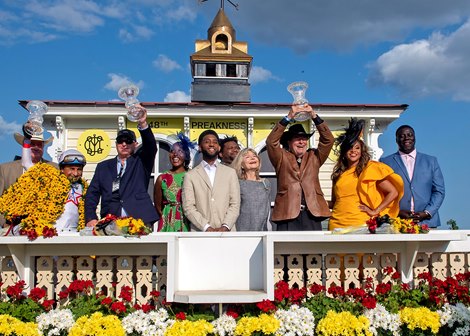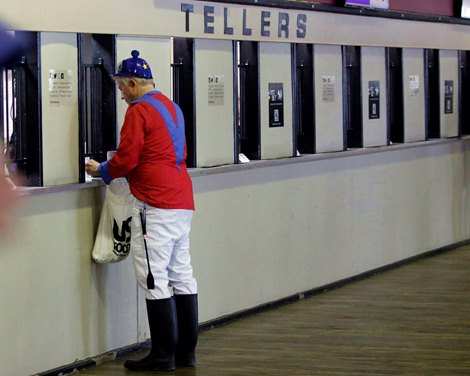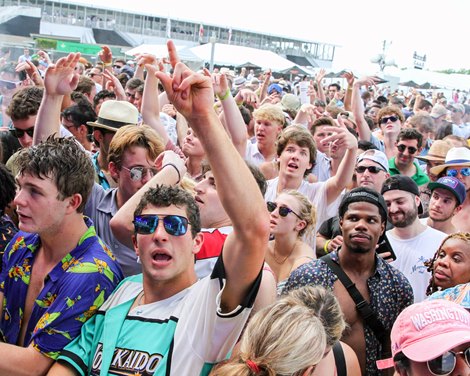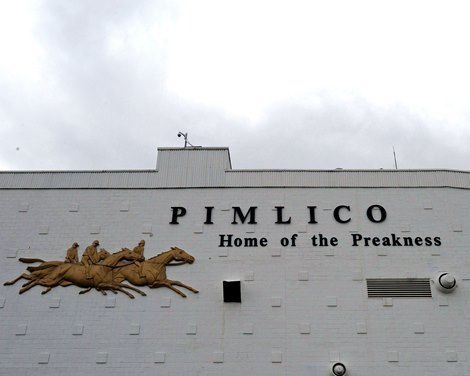When Maryland Gov. Wes Moore signed a state bill May 2 to put $400 million in bonds behind the building of a new Pimlico Race Course, it signaled that the home of the second leg of racing’s Triple Crown would join a renovated Churchill Downs and new Belmont Park as engines for the future of Thoroughbred racing.
A facility, however, is one thing, the racing program inside it is quite another.
As part of the “Pimlico Plus” legislation, a yet-to-be formed nonprofit entity will assume control of the Maryland Jockey Club Jan. 1, 2025, to run day-to-day operations of racing in the state, leaving the Preakness and Black-Eyed Susan cards in the hands of present owner 1/ST Racing (the Stronach Group) for the next two years. After that, the nonprofit takes charge of the two big days and the state will pay 1/ST an annual license fee and percentage of the two-day handle in exchange for operating rights.
What kind of stakes racing should be offered at the shiny new racetrack in Baltimore when it opens in 2027? As it stands, thanks in large part to scheduling and the larger amounts of added gaming money going to purses in Kentucky and New York, the prize money around the Kentucky Derby and Belmont Stakes cards dwarfs what Maryland puts up for Preakness week.
From May 1-4, Churchill ran 21 stakes races worth $17.5 million. The 2024 Belmont Stakes Racing Festival, climaxing June 8 with the Belmont Stakes (G1) at Saratoga Race Course, offers 24 stakes worth $10,250,000. While the Preakness Stakes (G1) purse was increased to $2 million this year, Pimlico will offer 15 stakes worth $4.3 million this weekend, May 17-18.
Sign up for BloodHorse Daily
With those differences in place, except for the Preakness, the top horses from around the country won’t be at Pimlico. They will follow the money to the big race cards that bookend it.
The once-robust Maryland stakes program has been in decline or static for more than 20 years, dating to 2001 when industry infighting led the state government to withdraw a subsidy and the tracks, under pressure from horsemen to maintain purse levels for bread-and-butter races, responded by slashing 33 stakes races worth $2.33 million. The following year, the Pimlico Special—long one of the most important races in the country—was axed along with eight other stakes, while purses were reduced on nine more, for a savings of $1.53 million.
Following years of missteps and dysfunction, particularly a missed opportunity in 2009 to install 4,750 slot machines at Laurel Park, the stakes program has never recovered.
Prime examples of the stakes stagnation are three $100,000 stakes this weekend: the Gallorette Stakes (G3T) for fillies and mares on the turf; the Allaire DuPont Stakes, a sister race on the dirt; and Friday’s marquee race, the Black-Eyed Susan Stakes (G2) for 3-year-old fillies.
The Gallorette, which dates to 1952, was won by National Racing Hall of Fame member Searching twice in its first six years and achieved grade 3 status in 1973. Its purse was boosted to $94,790 in 1979, and 45 years later that purse is virtually the same, up less than $6,000. It was run for $150,000 the past 11 years until being cut this year, likely to help pay for the Preakness purse hike.
The DuPont came into its own as a quality grade 3 race in 1994 but has been gasping of late and finally was moved to listed status by the American Graded Stakes Committee. The race debuted in 1992 with a $250,000 purse. It has lost 60% of its value.
The Black-Eyed Susan is a cornerstone Maryland stakes with an entire day celebrating it, but at $300,000, no winner of the $1.5 million Kentucky Oaks (G1) has much reason to go forward and enter it.

The connections of Taxed celebrate victory in the 2023 Black-Eyed Susan Stakes at Pimlico Race Course
Looking to the future, the adage “you have to spend money to make money” is in direct conflict with the Maryland Thoroughbred Horsemen’s Association’s distaste for having powerful out-of-town outfits come to Pimlico to raid big purses Preakness week. The local horsemen would rather see the money in overnight purses, but big races and top horses draw fans and gamblers to the biggest race days of the year in Maryland, boosting handle, which in turn supports purses. So, what gives?
“Our goal is to be top tier,” said Alan Foreman, who acts as general counsel for the MTHA and is a member of the Maryland Thoroughbred Racetrack Operating Authority, an entity created by the state legislature to shepherd through the “Pimlico Plus” plan and is responsible for organizing the nonprofit to operate the track. “I don’t know how realistic that is. We want to restore Maryland racing to the level it once enjoyed and the reputation it once enjoyed. Maryland is still pretty highly regarded. The horsemen still think this is a great place to race, live, and train.”
While the future of the forgone Laurel Park property is up in the air, Craig Fravel, the executive vice chair of Racing and Gaming for The Stronach Group, said the deal for the state to take over operations and concentrate racing at Pimlico creates a path for the future even though the road was hard to get there.
“The last few years have been a challenge,” Fravel said. “The original plan was ambitious, perhaps overly so. There was not enough [state] money to build two racetracks. The nice part is that people got together and thought creatively and came up with a plan that made lemonade out of lemons. So, I think it’s a really positive evolution of the deal. There were some painful moments along the way, but I think we are in a good spot.
“This is a big opportunity for Maryland to take control of its own destiny and for track operators and horsemen to be on the same page financially and from a strategic standpoint.”
AT A CROSSROADS
From 2013-2022, racing at Laurel Park and Pimlico experienced handle growth of 21.9%, according to a study by Crossroads Consulting, which contracted with the MTROA for a review and analysis of Thoroughbred racing in the state. Crossroads, based in Washington, D.C., has long served as an economic adviser to the Maryland Stadium Authority, which owns and operates M&T Bank Stadium, where the Ravens play, and Oriole Park at Camden Yards.
Even with the rise in handle, however, racing purses in the state are overwhelmingly at the mercy of support from 6% contributions of video lottery terminal revenue at the state’s casinos, which account for 81.9% of all purse money, according to Crossroads.

Video lottery revenue, and not betting handle on races, is driving purses at many tracks, including Pimlico
Maryland “has done a good job relative to its peers of maintaining purses at reasonable levels and preserving racing days, which directly support the perpetuation of strong racing and breeding industries in the state,” Crossroads wrote in its report.
The consultant suggested the industry target a 35% increase to purses to bring the average race to $60,000, which would put it in line with purses at Colonial Downs, in neighboring Virginia, which in 2022 was purchased by Churchill Downs Inc. The average would be higher than tracks in other Mid-Atlantic states but still lower than “elite racing states,” Crossroads noted.
To boost purses, Crossroads said the new nonprofit would need to implement aggressive marketing and promotion of racing, increase fees accrued from advance-deposit wagering companies that take bets on Maryland racing, and, perhaps most importantly, get historical horse racing machines legalized and installed at Pimlico.
The machines, which have galvanized overnight and stakes purses in Arkansas, Kentucky, and Virginia, are basically slot machines with winning combinations based on horse race replays and payouts based on a pari-mutuel formula.
Their impact cannot be stated strongly enough. In the fiscal year ending in June 2023, slot machines at Maryland casinos contributed $63 million to state purses. By comparison according to a Maryland Jockey Club presentation to the MTROA, historical horse racing machines, on-track and at off-site facilities, poured $27 million into Virginia’s purses, while in Kentucky that total reached $131 million. Races for maidens in Kentucky now have larger purses than many stakes on the Preakness card.
Trainer Ken McPeek, who closely studies the racing industry and whose Kentucky Derby (G1) winner Mystik Dan will run in the Preakness, understands the predicament Maryland is in without an influx of new dollars.
“If you bump up the purses, you’re going to get an overpayment in the horsemen’s account, and tracks don’t want to have an overpayment in the horsemen’s account,” McPeek said. “That throws the balance of purses out. I can see why racetracks would be hesitant to do that. If they overpay, they have to find that money from another source. These are things that racetrack executives deal with, and horsemen’s groups sit down with them and say, ‘How should we distribute this money?’
“I know [Maryland is] tested by the purse structure in Kentucky. The purse structure in Kentucky—state law is dictating what kind of revenue they’re able to pull in [through HHR]. Maryland and its politicians need to look at that to take it to another level.”
A possible impetus for the Maryland racing industry to push hard for legalizing HHR is a provision in the Pimlico Plus plan that takes $5 million a year from the purse account and puts it in the State Lottery Fund until the $400 million in bonds is paid. The Maryland Horse Council said the state put that in “to minimize the burden on the taxpayer.” Even more precarious, the law states, “For any fiscal year that MTROA reports an operating loss, that loss must be offset by a transfer from [purse account] proceeds allocated to Thoroughbred purses.”
LOSING MONEY
A primary stressor on Maryland racing has been 1/ST’s inability to make money. In 2022, the company listed its net revenue in Maryland at $32.5 million with expenses of $46.5 million. The company has posted a negative cash flow in Maryland every one of the past 10 years.
1/ST tried several times to reduce the number of racing days in the state, but horsemen fought back. To keep year-round racing, with 164 live dates in 2022, the MTHA and the Maryland Horse Breeders Association agreed to jointly pay 1/ST $5.2 million from wagering revenue to defray operational costs, according to a Maryland Jockey Club report.
Since a 10-year operating agreement between 1/ST and horsemen expired in December 2022, racing has been operating under a series of extensions that run to the end of this year. The MTHA reported that total support payments to 1/ST reached $11.4 million last year.
“That was a very unique arrangement that we made here,” Foreman said. “Remember in 2009 when Frank Stronach filed an application for a slots license and didn’t pay the fee that was required and Laurel was disqualified as a destination facility for slots? There was no possibility for a Thoroughbred track in Maryland being a racino like in Delaware, Pennsylvania, or West Virginia. Because of the dereliction of Frank Stronach, in terms of getting slots to Laurel, the horsemen willingly entered into an agreement to punish themselves.
“We maintained purses that support the businesses, plus bonuses for the breed-fund program so that we could run on a year-round basis here. That’s the best we could do.”

The Chainsmokers perform at the Preakness in 2022
Since Frank Stronach’s daughter Belinda took leadership of the company in 2018, earnings from Preakness day, which used to help support the entire year, have collapsed. Focusing heavily on celebrity appearances and pop concerts unrelated to racing, 1/ST lost $2.9 million on the Preakness in 2022 and $1.9 million last year.
“Their whole thing was to turn the Preakness into—I guess you would call it—a party like you would see in South Beach, Florida,” Foreman said. “They alienated the Maryland customer and a lot of people nationally. They just changed the whole look of the Preakness and the whole operation of the Preakness. It used to be the people’s party. It used to be a Maryland racing party, and they took that all away.”

The infield concert at the Preakness in 2022
Reasons for Optimism
While that’s been the recent past, David O’Rourke, CEO and president of the New York Racing Association, said Maryland should be optimistic about the future of the Preakness. O’Rourke is overseeing an ongoing complete rebuild of Belmont Park, which Maryland, in many ways, is trying to emulate at Pimlico.
“Let’s be fair; [Maryland] just got a building approved,” O’Rourke said. “So, now there is an opportunity to establish a path. We went through this ourselves. Maryland has now got an opportunity to set the definition of themselves. Give it a chance. They haven’t even got the reins yet.
“You’re going to see some really good things coming out of it. You won’t see them all at once. There are some constraints on purses; they’re not equally distributed around the country, so that creates challenges. However, when you have a marquee brand like the Preakness, everybody goes. All the eyeballs are on it on national television, so you’ve got the platform.”
McPeek said he and other trainers would appreciate the oft-discussed greater spacing between Triple Crown weekends, suggesting the first weekends in May, June, and July. He called the Black-Eyed Susan the logical next step for the winner of the Kentucky Oaks, which he won this year with Thorpedo Anna .
“That’s a race I’d like to see get a purse increase or shift the timing because there’s no 3-year-old filly race to follow the Oaks,” he said. As it stands, he said, “There’s no motivation to run a filly that runs well in the Kentucky Oaks back in the Black-Eyed Susan. That’s not going to happen.”
Yet even if purse increases for stakes come together, the Maryland program will be challenged by scheduling because it would be hard to convince NYRA to push back the Belmont Stakes Racing Festival into July because of how it has designed its stakes program. O’Rourke said the Belmont festival is “a steppingstone into our Saratoga stakes schedule, and since we’ve built that product, the timing of the stakes is important in how it flows into Saratoga and all these other stakes.”
Foreman, who also is chairman and CEO of the Thoroughbred Horsemen’s Association, didn’t want to take a position on whether Maryland stakes purses need to reach for more parity with the other two Triple Crown race programs, but he acknowledged the tension in the decision-making ahead about it.

The silks of 2023 Preakness Stakes winner National Treasure are painted onto the weather vane at Pimlico Race Course
“The purses that will be paid out on Black-Eyed Susan and Preakness Day will be part of the overall plan that we have for this industry on a year-round basis,” he said. “We get that tension, and the tension will always be there when the horsemen say you shouldn’t pay out giant sums of money on those two days to trainers and owners who are coming from out of state, and it’s better to spread that money around for the industry the rest of the year. And there are those who say if you want to generate more handle and more interest that will benefit the industry on an annual basis, pump up the purses on those two days. It’s a philosophical discussion and a business decision that will have to be made by the new authority.
“No discussion about that has been held. People right now are stunned by the fact that we have even been able to pull this all off,” Foreman said of the coming of a new Pimlico. “Nobody thought we could do it.”
BloodHorse senior correspondent Bob Ehalt contributed to this story.









Leave feedback about this